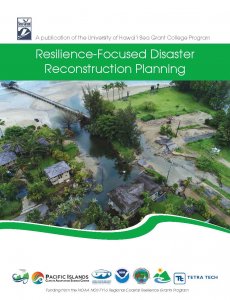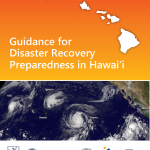Hawai‘i’s coastal communities are particularly vulnerable to impacts from hurricanes, tsunamis, and other coastal disaster events due to the state’s isolated location in the Pacific and development concentrated along low-lying shores. Impacts from infrequent coastal disaster events will become more severe with climate change and sea level rise. Human impacts to coastal environments that act as natural barriers including beaches and reefs also makes our communities more vulnerable to impacts from storms and high waves. The ability to build back safer, stronger, smarter, and faster after a damaging disaster while considering potential impacts to natural and cultural resources is a critical aspect of community resilience. This requires careful planning among government agencies and communities long before a disaster occurs.
Through a National Oceanic and Atmospheric Administration (NOAA) Regional Coastal Resilience Grant, the Hawaiʻi Sea Grant College Program together with the State of Hawaiʻi Department of Land and Natural Resources (DLNR), Office of Planning, and Tetra Tech, Inc., developed statewide guidance documents and tools to improve community resilience to coastal hazards and sea level rise. These guidance documents and tools support implementation of the recommendations of the Hawaiʻi Sea Level Rise Vulnerability and Adaptation Report (Hawai’i Climate Mitigation and Adaptation Commission 2017) especially to integrate sea level rise adaptation plans and policies into state, county and community plans and to develop pre-disaster recovery frameworks at the state and county levels that incorporate opportunities to adapt to sea level rise through disaster recovery.



